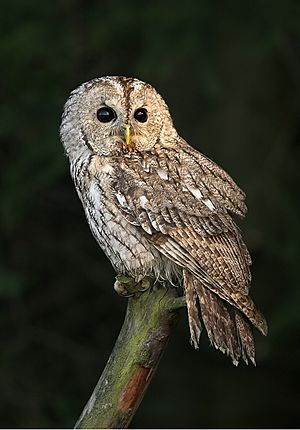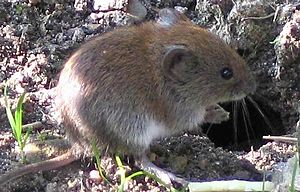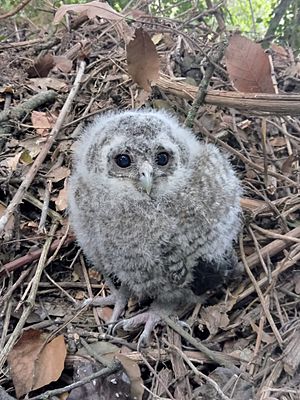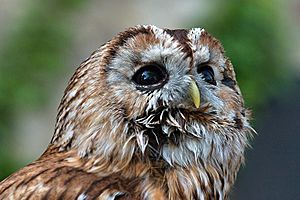Tawny owl facts for kids
Quick facts for kids Tawny owl |
|
|---|---|
 |
|
| A grey tawny owl | |
| Conservation status | |
| Scientific classification | |
| Genus: |
Strix
|
| Species: |
aluco
|
 |
|
| Where tawny owls live | |
| Synonyms | |
|
Strix stridula Linnaeus, 1758 |
|
The tawny owl (Strix aluco), also called the brown owl, is a common bird found in woodlands across Europe and western Siberia. There are seven types, or subspecies, of tawny owls. This owl is a strong, medium-sized bird. Its belly is light with dark stripes. Its back can be either brown or grey. Some tawny owls can be either color.
Tawny owls usually build their nests in holes in trees. This helps them keep their eggs and young safe from animals that might try to eat them. Tawny owls do not migrate, meaning they stay in the same place all year. They are also very territorial. This means they protect their space. Because of this, young owls often starve if they cannot find an empty area to live in after leaving their parents.
The tawny owl is a nocturnal bird of prey. This means it hunts at night. It can hunt well in the dark because of its special eyes and ears. It can also fly very quietly. The owl usually hunts by dropping quickly from a branch. It then grabs its prey and swallows it whole. Tawny owls mainly hunt rodents. But in cities, they eat more birds. They sometimes catch smaller owls. Bigger birds like the eagle owl and the northern goshawk sometimes hunt tawny owls.
Many people think tawny owls have amazing night vision. But their eyes are not much better than human eyes. Their excellent hearing is more important for hunting. Their ears are placed unevenly on their head. This helps them figure out exactly where a sound is coming from.
Tawny owls appear in old stories. Because they are active at night and make a spooky sound, people used to think they brought bad luck or death. Many people believe all owls hoot. But this sound is mostly made by the tawny owl. Also, the double hoot, which many people think is one owl, is actually a male and female calling back and forth.
Contents
About the Tawny Owl
The tawny owl is a strong bird. It is about 37 to 46 centimeters (15 to 18 inches) long. Its wings can spread 81 to 105 centimeters (32 to 41 inches) wide. It weighs from 385 to 800 grams (0.8 to 1.8 pounds). It has a large, round head with no ear tufts. The feathers around its dark brown eyes are usually plain.
This owl has two main feather colors, called morphs. One type has reddish-brown feathers on its back. The other has grayish-brown feathers. Some owls have colors in between. The feathers on their belly are whitish with brown stripes. Owls slowly replace their feathers between June and December. Female tawny owls are larger than males. They are 5% longer and more than 25% heavier.
Tawny owls fly by gliding on their rounded wings. They flap their wings less than other owls in Europe. They also fly higher. Their flight is quite heavy and slow, especially when taking off. But they can fly up to 50 miles per hour. Like most owls, their flight is silent. This is because their feathers have soft, furry tops. The front edge of their outer wing feathers also has a fringe. This silent flight helps them sneak up on prey.
The tawny owl's size, squat shape, and wide wings help tell it apart from other owls. Other owls like the great grey owl, Eurasian eagle-owl, and Ural owl look similar but are much bigger.
An owl's eyes are at the front of its head. This gives it better binocular vision than other birds of prey. This means they can see depth better. An owl's eye has many light-sensing cells. This helps them see well in low light. But their eyesight is only a little better than humans. Any extra sensitivity is because of how their eyes are built. Both humans and owls have eyes that are as good as they can get for land animals.
To see at night, owls have large, tube-shaped eyes. They have many light-sensing cells packed closely together. They do not have many color-sensing cells. This is because light-sensing cells work better in dim light. Unlike birds that hunt during the day, owls usually have only one fovea. This part of the eye is not very developed in owls.
Hearing is very important for an owl that hunts at night. Like other owls, the tawny owl's two ear openings are different. They are placed unevenly. This helps them hear where sounds are coming from. A passage inside their skull connects their eardrums. Small differences in when a sound reaches each ear help them find its source. The left ear opening is higher than the right ear. It also points down. This helps it hear sounds from below better. Feathers cover both ear openings. These feathers are special because sound can pass through them easily.
The inside of the owl's ear has many hearing cells. This helps them hear low-frequency sounds from far away. This includes the rustling sounds of prey moving in plants. The tawny owl's hearing is ten times better than a human's. It can hunt using only its hearing in a dark forest on a cloudy night. But if it rains, the sound of raindrops makes it hard to hear faint sounds. Long periods of wet weather can make it hard for the owl to hunt. This can lead to starvation.
The female tawny owl makes a sharp kew-wick sound. The male has a shaky hooting song: hoo...ho, ho, hoo-hoo-hoo-hoo. The famous writer William Shakespeare used this owl's song in a play. He wrote "Then nightly sings the staring owl, Tu-whit; Tu-who, a merry note." But this well-known call is actually a duet. The female makes the kew-wick sound, and the male answers hooo. People can easily copy the call by blowing into cupped hands. A study found that owls responded to this sound in 94% of tries. Male owls that are healthy and strong respond more to calls from other owls. Males call more than females all year. They call most often when they are incubating eggs and after their young have left the nest.
Owl Colors and Sizes Around the World
Both brown and grey tawny owls live in Europe. Brown owls are more common in wet areas of western Europe. Grey owls are more common further east. In the far north, all the owls are a cold-grey color. Owls in Siberia and Scandinavia are 12% larger and 40% heavier. Their wings are 13% longer than owls in western Europe. This follows a rule that says animals in colder northern areas are often bigger than those in warmer southern areas.
The color of an owl's feathers is controlled by its genes. Studies in Finland and Italy show that grey tawny owls have more success raising young. They also have stronger immune systems and fewer parasites than brown owls. This might make you think brown owls could disappear. But owls do not seem to prefer one color over another when choosing a mate. So, the pressure for grey owls to be more successful is less strong.
Environmental factors also play a role. The Italian study showed that brown owls lived in denser forests. In Finland, it is thought that paler birds would be more common in the colder climate.
Tawny Owl Family Tree
The tawny owl was first described by Carl Linnaeus in his book Systema naturae in 1758. He gave it its current scientific name. The name comes from the Greek word strix meaning "owl." It also comes from the Italian word allocco, meaning "tawny owl." This Italian word comes from the Latin ulucus meaning "screech-owl."
The different types of tawny owls, called subspecies, are often hard to tell apart. Because of this, different scientists have said there are between 10 and 15 subspecies. Today, seven subspecies are officially recognized.
| Subspecies | Where it lives | Who described it |
|---|---|---|
| S. a. aluco | North and central Europe, from Scandinavia to the Mediterranean and Black Sea | Linnaeus, 1758 |
| S. a. biddulphi | Northwest India and Pakistan | Scully, 1881 |
| S. a. harmsi | Kazakhstan, Uzbekistan and Kyrgyzstan | (Zarudny, 1911) |
| S. a. sanctinicolai | West Iran, northeast Iraq | (Zarudny, 1905) |
| S. a. siberiae | Central Russia, from the Urals to west Siberia | Dementiev, 1934 |
| S. a. sylvatica | West and southern Europe, west Turkey | Shaw, 1809 |
| S. a. willkonskii | Northeast Turkey and northwest Iran to Turkmenistan | (Menzbier, 1896) |
Where Tawny Owls Live
Tawny owls do not migrate. They live in temperate Europe, from Great Britain and the Iberian Peninsula east to western Siberia. They are not found in Ireland. This might be because of competition from the long-eared owl. They are also rarely seen in the Balearic and Canary Islands. In the Himalayas and East Asia, other similar owls live there. In northwest Africa, the closely related Maghreb owl lives there.
These owls live in forests with deciduous (trees that lose leaves) and mixed trees. They sometimes live in older conifer (evergreen) tree farms. They like places with water nearby. Cemeteries, gardens, and parks have helped them move into cities, even central London. Tawny owls live in cities, especially those with natural forests. But they are less likely to be in places with a lot of noise at night.
Tawny owls are mostly found in lowlands in colder areas. But they can live higher up in mountains. They live up to 550 meters (1,800 feet) in Scotland. They can be found at 1,600 meters (5,200 feet) in the Alps. In Turkey, they go up to 2,350 meters (7,700 feet). In Myanmar, they live up to 2,800 meters (9,200 feet).
The tawny owl lives in a very large area, at least 10 million square kilometers (3.8 million square miles). There are many of them, with an estimated 970,000 to 2 million owls in Europe alone. Their numbers are generally increasing. This owl is not considered in danger of disappearing. So, it is listed as a species of least concern by the IUCN Red List. In the UK, it is on a list that means it needs some attention. This species has spread to new areas in Belgium, the Netherlands, Norway, and Ukraine. Their numbers are stable or growing in most European countries. But they have decreased in Finland, Estonia, Italy, and Albania. Tawny owls are listed in a special agreement called CITES. This means that international trade of these owls is controlled.
Tawny Owl Life Cycle
Breeding and Raising Young
Tawny owls find a partner when they are one year old. They usually stay together for life. A pair of owls will defend their territory all year. Their territory usually stays the same size each year. The pair sits hidden on a branch close to a tree trunk during the day. They usually sleep in different spots from July to October. Smaller birds might bother sleeping owls during the day. But the owls usually ignore them.
Tawny owls are very territorial. They show where their territory is by calling out. They call most often at night. But some owls will call during the day too. The owl chooses its home area in early autumn. It defends this area through winter and into spring when breeding starts.
The tawny owl usually builds its nest in a hole in a tree. But they also use old nests of European magpies, squirrel nests, or holes in buildings. They will also use nest boxes that people put up. They start nesting in February in warmer areas. But in Scandinavia, they rarely nest before mid-March.
Their eggs are shiny white. They are about 48 by 39 millimeters (1.9 by 1.5 inches) in size. Each egg weighs about 39 grams (1.4 ounces), with 7% of that being the shell. A typical clutch has two or three eggs. The female owl sits on the eggs for 30 days until they hatch. The baby chicks are born helpless and covered in soft down. They leave the nest in another 35 to 39 days. The female usually incubates the eggs alone. But sometimes the male helps. The young owls usually leave the nest up to ten days before they can fly well. They hide on nearby branches.
This owl is very brave when protecting its nest and young. Like other Strix owls, it will attack an intruder's head with its sharp talons. Because its flight is silent, you might not know it's there until it's too late. Dogs, cats, and humans can be attacked. Sometimes this happens without being provoked. A famous example is the bird photographer Eric Hosking. He lost his left eye when an owl attacked him near its nest in 1937. He later named his book An Eye for a Bird.
The parents take care of the young owls for two or three months after they can fly. But from August to November, the young owls leave to find their own territory. If they cannot find an empty area, they usually starve. We don't know how many young owls survive. But about 76.8% of adult owls survive each year. Tawny owls usually live for five years. But one wild tawny owl lived for over 18 years. A captive owl lived for over 27 years.
Bigger birds like Ural owls, eagle owls, northern goshawks, golden eagles, and common buzzards hunt tawny owls. Pine martens might raid nests, especially in nest boxes. There have been cases of Eurasian jackdaws building nests on top of a female tawny owl. This led to the death of the adult and chicks. A study in Denmark showed that mammals, especially red foxes, caused many deaths in young owls. About 36% died between leaving the nest and becoming independent. The risk of death increased if they left the nest later. This suggests that breeding early helps owls survive.
This species is more and more affected by avian malaria. The number of cases has tripled in the last 70 years. This matches the increase in global temperatures. A one-degree Celsius rise in temperature causes a two to three times increase in malaria. In 2010, 60% of British tawny owls had malaria. In 1996, only 2-3% had it.
What Tawny Owls Eat

The tawny owl hunts almost entirely at night. It watches from a perch. Then it drops or glides silently down to its prey. Very rarely, it will hunt during the day if it has young to feed. This owl eats many different animals. It mainly eats rodents from the forest. But it also eats other mammals, even young rabbits. It also eats birds, earthworms, and beetles. In cities, birds make up more of their diet. They have even eaten birds like mallards and kittiwakes.
The owl usually swallows its prey whole. It then spits out parts it cannot digest, like fur and bones. These are called pellets. They are medium-sized and grey. They are mostly made of rodent fur and often have bones sticking out. You can find them in groups under trees where owls sleep or nest.
Smaller woodland owls, like the little owl and the long-eared owl, usually cannot live in the same areas as the stronger tawny owls. Tawny owls might eat them. So, these owls live in different places. In Ireland, the absence of the tawny owl allowed the long-eared owl to become the main owl. Also, when tawny owls move into cities, they tend to push barn owls out of their usual nesting spots in buildings.
Tawny Owls in Stories
The tawny owl, like other owls, has often been seen as a sign of bad luck. William Shakespeare used it this way in his play Julius Caesar. He wrote: "And yesterday the bird of night did sit/ Even at noon-day upon the market-place/ Hooting and shrieking." The writer John Ruskin once said, "Whatever wise people may say of them, I at least have found the owl's cry always prophetic of mischief to me."
The poet Wordsworth described how to call an owl in his poem "There Was a Boy."
And there, with fingers interwoven, both hands
Pressed closely palm to palm and to his mouth
Uplifted, he, as through an instrument,
Blew mimic hootings to the silent owls,
That they might answer him.—And they would shout
Across the watery vale, and shout again,
Responsive to his call,—with quivering peals,
And long halloos, and screams, and echoes loud
Redoubled and redoubled; concourse wild
Of jocund din!
Images for kids
-
Tawny owls are quite nocturnal
See also
 In Spanish: Cárabo común para niños
In Spanish: Cárabo común para niños











